Parameterization of Wildfire Injection Plume Height
December 2015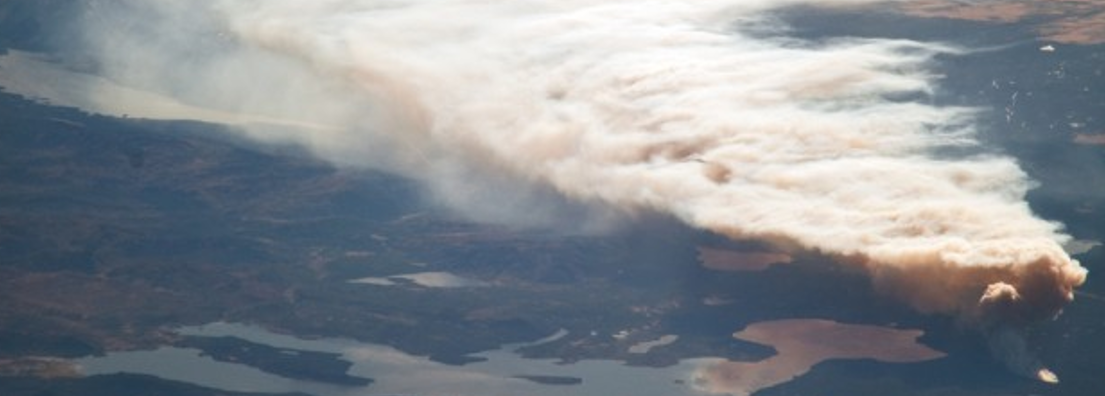 Arnica Fire on the 09/24/09, Yellowstone National Park, Wyoming. (Credits: NASA, International Space Station)
Arnica Fire on the 09/24/09, Yellowstone National Park, Wyoming. (Credits: NASA, International Space Station)
The atmospheric scientific community has been studying the impact of wildland fire on the Earth system for a long time. Because of the global distribution and the unpredictable and strongly varying nature of wildfire activity, Burning Biomass (BB) emission inventories are usually derived from satellite Earth Observation (EO) data. Different methods exist to convert EO data into emission inventories. They are either based on (i) top-down approaches using inverse modelling and satellite-based retrievals of atmospheric trace gases, or (ii) bottom-up methods related to use of EO products more directly targeting fire on the landscape, such as the burned area or the Fire Radiative Power (FRP).
Alike volcanic or aircraft emissions, fire emission can reach altitude of several kilometers. To fully parameterize BB in global chemistry transport model, together with their emissions, information on the plume updraft also need to be provided. While working at Kings College London with Martin Wooster, I developed such injection height parameterization for the Global Fire Assimilation System (GFAS) which is maintained by the European Center for Medium Weather Forecast (ECMWF). The parameterization is now run operationally at ECMWF (Remy et al 2017) and can be retrieved form the GFAS archive here.
Quick Overview
The approach is based on the plume rise model (PRM) developed by Saulo Freitas where the fire convective flux was set using radiative flux measurement based on the Fire Radiative Power product (FRP). PRM was originally developed to take into account effects of atmospheric stability and latent heat in plume updraft. Here, the original version is further modified: (i) the input data of convective heat flux and Active Fire area are directly force from FRP data derived from a modified version of the Dozier algorithm applied to the MOD12 product, (ii) and the dynamical core of the plume model is modified with a new entrainment scheme inspired from latest results in shallow convection parametrization. The new parameters introduced are then defined via an optimization procedure based on (i) fire plume characteristics of single fire events extracted from the official MISR plume height project and (ii) atmospheric profile derived from the ECMWF analysis. The new model was named PRMv2.
Calibration/optimization of PRMv2 was made for North America. Fire events were selected out of the MISR data set. In particular, I found that the only information extracted from Terra overpass is not enough to guaranty that the available measure of injection height from MISR is linked to the FRP measured at the same time by the MODIS sensor based on Terra. The plume is a dynamical system, and a time delay (related to the atmospheric state) is necessary to adjust change in FRP to the plume behaviour. Therefore, multiple overpasses of the same fire from Terra and Aqua were used here to determine fire and plume behaviours and system in a steady state at the time of MISR (central scan of Terra) overpass were selected for the optimization procedure.
Results show that
- this parametrization was the only one at the time of its release to response to atmospheric stability as expected from the observation of Val Martin et al 2010.
- and in the case of some fire event, PRMv2 was able to predict the formation of a pyroconvective cloud where observation from Aqua overpass show massive change in plume behaviour.
Prior to its use at ECMWF, the parametrization was run for some dedicated year of the MODIS archive. In particular, the year 2003 was used to emphasize PRMv2 response to atmospheric stability. A simple gridded product was also output, without the data assimilation of GFAS, using 6h persistence for every detected fire. An example of time-integrated 3D distribution of BB consumption mass is shown below for the 4 seasons of the year 2003. The conversion form FRP to gas emission was done using the same conversion and emission factors as in GFAS (Kaiser et al 2012) and then gridded on a 0.1 degree mesh.
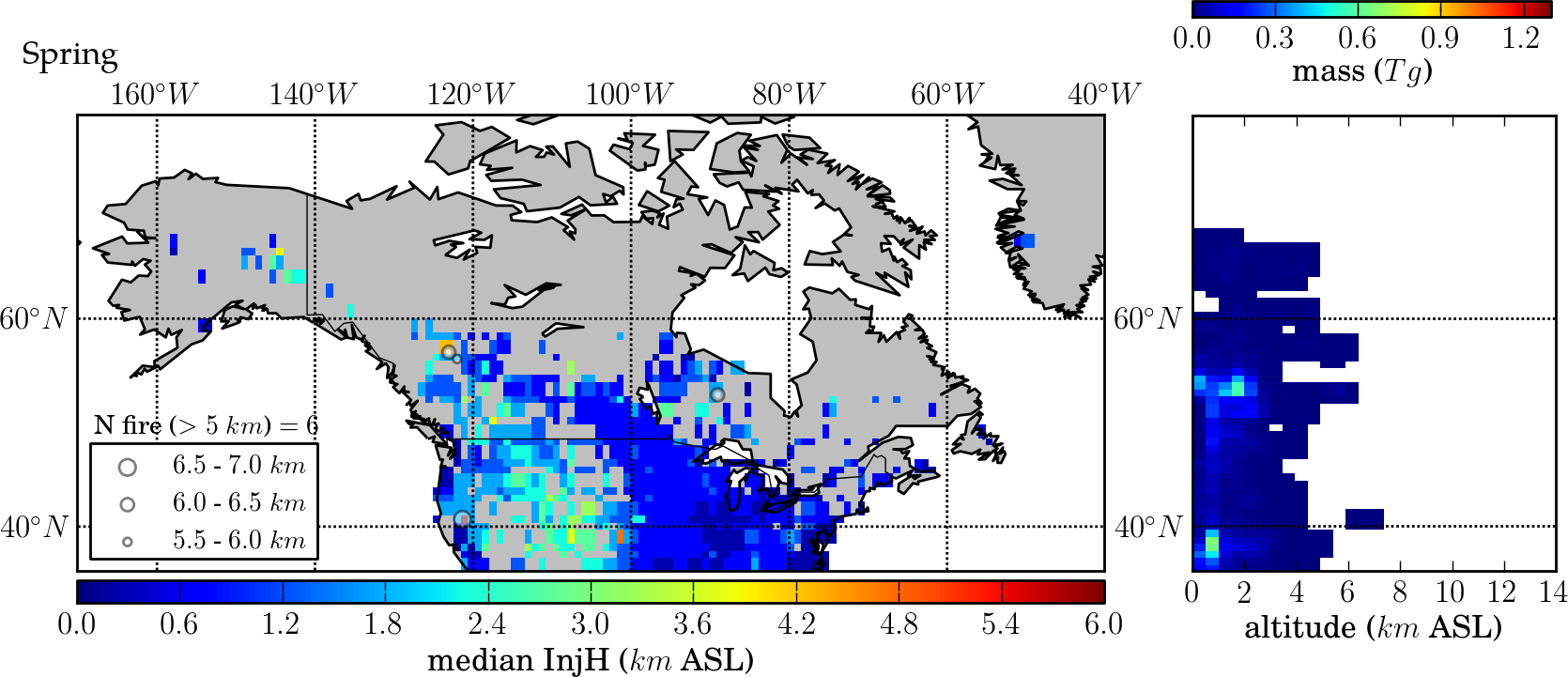
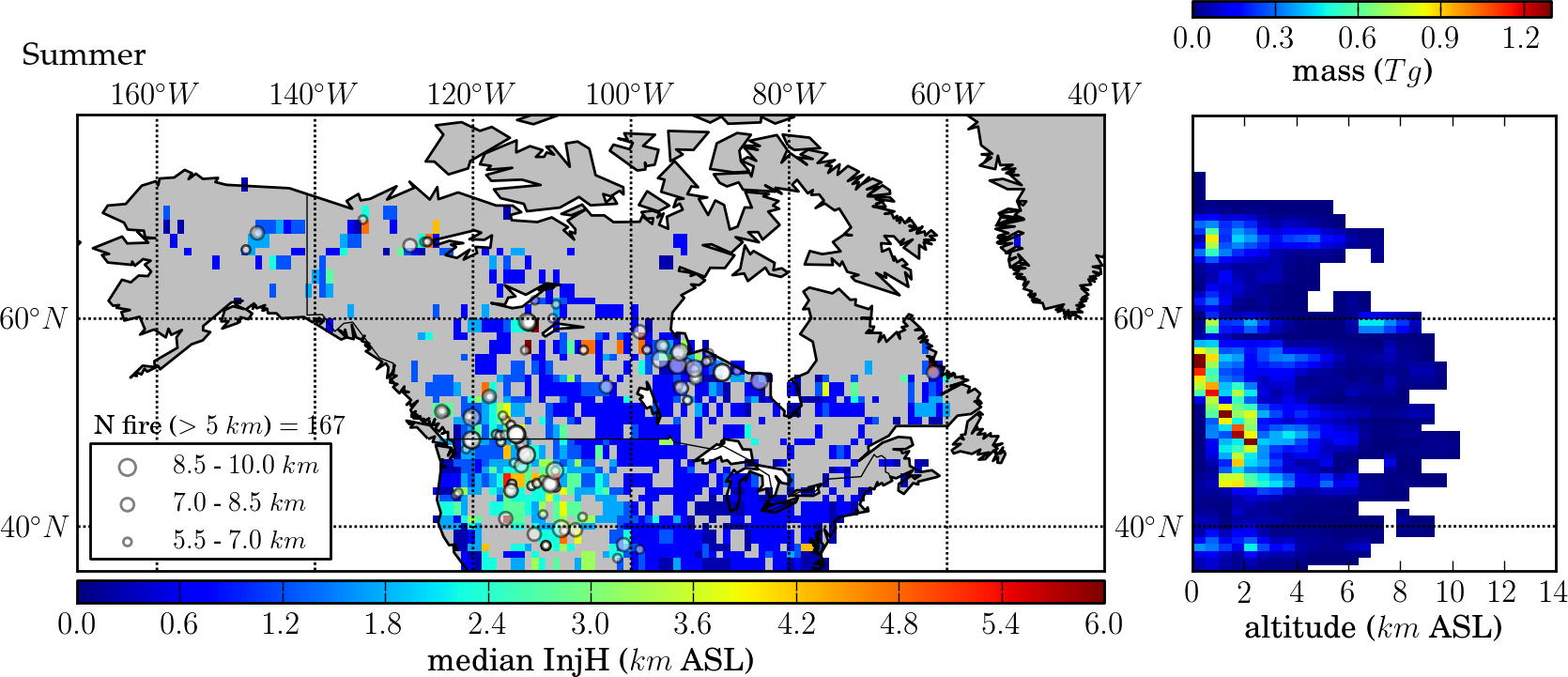
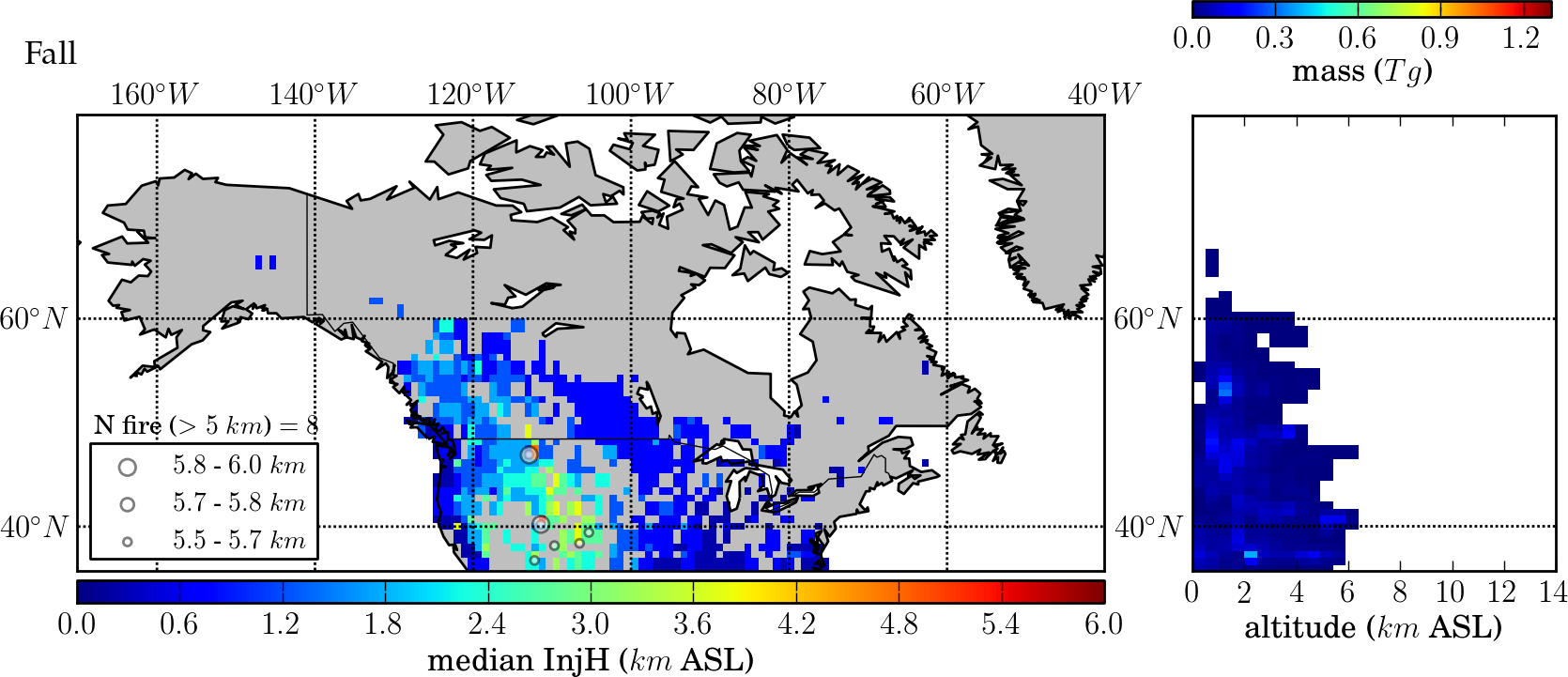
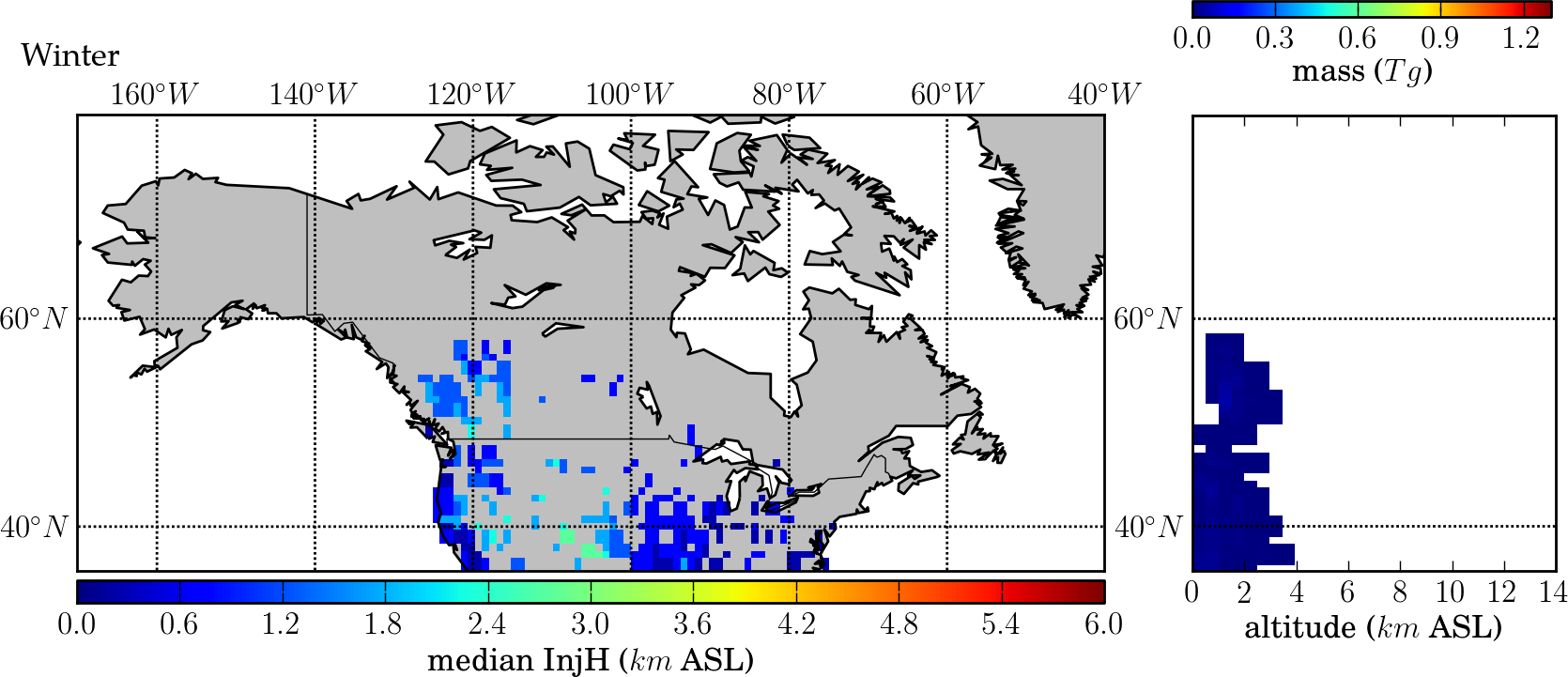 Seasonal maps of the distribution of landscape fire smoke plume injection height (InjH) over North America, calculated for the year 2003 from MODIS active fire product data, a simple model of 6 h fire persistence, and the optimised PRMv2 model. Results are shown
gridded at 1.0 degree , with a 500 m vertical grid resolution. For each season, the left column shows the
horizontal distribution of the seasonally integrated InjH median (equal fire-consumed mass is
located below and above), single fire events having a modelled plume height above 5 km, whilst
the vertical distribution of the emissions from the burnt biomass integrated over all longitudes
are shown in the right column
Seasonal maps of the distribution of landscape fire smoke plume injection height (InjH) over North America, calculated for the year 2003 from MODIS active fire product data, a simple model of 6 h fire persistence, and the optimised PRMv2 model. Results are shown
gridded at 1.0 degree , with a 500 m vertical grid resolution. For each season, the left column shows the
horizontal distribution of the seasonally integrated InjH median (equal fire-consumed mass is
located below and above), single fire events having a modelled plume height above 5 km, whilst
the vertical distribution of the emissions from the burnt biomass integrated over all longitudes
are shown in the right column
Behind the scene
The detail of the development of PRMv2 was published (Paugam et. al. 2015) as a dicussion paper in the journal Atmospheric Chemistry Physics (ACP), while a review on plume rise parameterization was issued as a research paper (Paugam et al 2016).
The optimization of PRMv2 hold on the selection of fires from the MISR data set where the system fire-plume is in a steady state. Using only information from MODIS (Terra and Aqua sensors) observations, our selection criteria filtered out most of the available MISR fires, keeping only 36 plumes out of the ~3000 present at the time in the official MISR data set. This is a choice that is clearly outlined in Paugam et al 2015, and doing such a choice we showed that our model have a better statistical response to atmospheric stability than other model.
However, this was not accepted by two reviewers out of three (one not being published in the discussion thread) and the editor of the manuscript. One of the reviewer even felt free to use a relative aggressive wording to dismantle the manuscript:
- The author group includes well-known names in the fire research area, so I started the reading with high hopes. Unfortunately, the paper appeared disappointing in several senses described below. This is highly surprising since I am familiar with many papers of some of the manuscript authors. After spending a lot of time digging in this one, I had to accept that they did not pay enough attention to it.
- This must be a joke!! Do the authors really think that correlation can be meaningfully computed for 3 points?? [note: this correlation was using 4 points, and is not at the core of PRMv2 validation]
Despite of all this bad science, PRMv2 was still implemented in GFAS. Features of the new GFAS release were published in ACP (Remy et. al. 2017) with among the authors the editor of my paper and most certainly my virulent reviewer.
Next
I have modified and started to rerun the analysis behind the MISR fires selection. This should hopefully increases the dataset size used in the optimization of PRMv2. To be continued…
Papers published using PRMv2
- Sauvage, B., Fontaine, A., Eckhardt, S., Auby, A., Boulanger, D., Petetin, H., Paugam, R., Athier, G., Cousin, J.-M., Darras, S., Nédélec, P., Stohl, A., Turquety, S., Cammas, J.-P., and Thouret, V.: Source attribution using FLEXPART and carbon monoxide emission inventories: SOFT-IO version 1.0, Atmos. Chem. Phys. Discuss., https://doi.org/10.5194/acp-2017-653, in review, 2017.
- Rémy, S., Veira, A., Paugam, R., Sofiev, M., Kaiser, J. W., Marenco, F., Burton, S. P., Benedetti, A., Engelen, R. J., Ferrare, R., and Hair, J. W.: Two global data sets of daily fire emission injection heights since 2003, Atmos. Chem. Phys., 17, 2921-2942, doi:10.5194/acp-17-2921-2017, 2017.
- Evangeliou, Nikolaos; Zibtsev, S.; Myroniuk, V.; Zhurba, M.; Hamburger, Thomas; Stohl, Andreas; Balkanski, Y.; Paugam, R.; Mousseau, T.A.; Møller, A.P.; Kireev, S.I.: Resuspension and atmospheric transport of radionuclides due to wildfires near the Chernobyl Nuclear Power Plant in 2015: An impact assessment. Scientific Reports, Nature, doi:10.1038/srep26062, 2016.
- Paugam, R., Wooster, M., Freitas, S., and Val Martin, M.: A review of approaches to estimate wildfire plume injection height within large-scale atmospheric chemical transport models, Atmos. Chem. Phys., 16, 907-925, doi:10.5194/acp-16-907-2016, 2016.
- Paugam, R., Wooster, M., Atherton, J., Freitas, S. R., Schultz, M. G., and Kaiser, J. W.: Development and optimization of a wildfire plume rise model based on remote sensing data inputs -Part 2, Atmos. Chem. Phys. Discuss., 15, 9815-9895, doi:10.5194/acpd-15-9815-2015, 2015. [still in review for acp in Sep 2015]
- Gonzi, S., Palmer, P. I., Paugam, R., Wooster, M., and Deeter, M. N.: Quantifying pyroconvective injection heights using observations of fire energy: sensitivity of spaceborne observations of carbon monoxide, Atmos. Chem. Phys., 15, 4339-4355, doi:10.5194/acp-15-4339-2015, 2015.
- N. Evangeliou, Y. Balkanski, A. Cozic, W. M. Hao, F. Mouillot, K. Thonicke, R. Paugam, S. Zibtsev, T. A. Mousseau, R. Wang, B. Poulter, A. Petkov, C. Yue, P. Cadule, B. Koffi, J. W. Kaiser, and A. P. Møller. Fire evolution in the radioactive forests of Ukraine and Belarus: future risks for the population and the environment. Ecological Monographs 85:49-72. 2015
- Val Martin, M., R. A. Kahn, J. A. Logan, R. Paugam, M. Wooster, and C. Ichoku, 2012: Space-based observational constraints for 1-D fire smoke plume-rise models, J. Geophys. Res., 117, D22204
References:
- Kaiser, J. W., Heil, A., Andreae, M. O., Benedetti, A., Chubarova, N., Jones, L., Morcrette, J.-J., Razinger, M., Schultz, M. G., Suttie, M., and van der Werf, G. R.: Biomass burning emissions estimated with a global fire assimilation system based on observed fire radiative power, Biogeosciences, 9, 527-554, https://doi.org/10.5194/bg-9-527-2012, 2012.
- Val Martin, M., Logan, J. A., Kahn, R. A., Leung, F.-Y., Nelson, D. L., and Diner, D. J.: Smoke injection heights from fires in North America: analysis of 5 years of satellite observations, Atmos. Chem. Phys., 10, 1491-1510, https://doi.org/10.5194/acp-10-1491-2010, 2010.